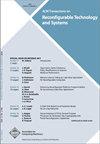NAPOLY: A Non-deterministic Automata Processor OverLaY
IF 3.1
4区 计算机科学
Q2 COMPUTER SCIENCE, HARDWARE & ARCHITECTURE
引用次数: 0
Abstract
Deterministic and Non-deterministic Finite Automata (DFA and NFA) comprise the core of many big data applications. Recent efforts to develop Domain-Specific Architectures (DSAs) for DFA/NFA have taken divergent approaches, but achieving consistent throughput for arbitrarily-large pattern sets, state activation rates, and pattern match rates remains a challenge. In this article, we present NAPOLY (Non-Deterministic Automata Processor OverLaY), an FPGA overlay and associated compiler. A common limitation of prior efforts is a limit on NFA size for achieving the advertised throughput. NAPOLY is optimized for fast re-programming to permit practical time-division multiplexing of the hardware and permit high asymptotic throughput for NFAs of unlimited size, unlimited state activation rate, and high pattern reporting rate. NAPOLY also allows for offline generation of configurations having tradeoffs between state capacity and transition capacity. In this article, we (1) evaluate NAPOLY using benchmarks packaged in the ANMLZoo benchmark suite, (2) evaluate the use of an SAT solver for allocating physical resources, and (3) compare NAPOLY’s performance against existing solutions. NAPOLY performs most favorably on larger benchmarks, benchmarks with higher state activation frequency, and benchmarks with higher reporting frequency. NAPOLY outperforms the fastest of the CPU and GPU implementations in 10 out of 12 benchmarks.非确定性自动机处理器叠加
确定性和非确定性有限自动机(DFA和NFA)构成了许多大数据应用的核心。最近为DFA/NFA开发特定领域架构(Domain-Specific Architectures, dsa)的工作采用了不同的方法,但是为任意大的模式集、状态激活率和模式匹配率实现一致的吞吐量仍然是一个挑战。在这篇文章中,我们提出了NAPOLY(非确定性自动机处理器覆盖层),一个FPGA覆盖层和相关的编译器。先前努力的一个常见限制是对NFA大小的限制,以实现所发布的吞吐量。NAPOLY针对快速重新编程进行了优化,以允许硬件的实际时分多路复用,并允许无限大小、无限状态激活率和高模式报告率的nfa的高渐近吞吐量。NAPOLY还允许离线生成具有状态容量和转换容量之间权衡的配置。在本文中,我们(1)使用封装在ANMLZoo基准测试套件中的基准测试来评估NAPOLY,(2)评估使用SAT求解器来分配物理资源,以及(3)将NAPOLY的性能与现有解决方案进行比较。NAPOLY在较大的基准测试、具有较高状态激活频率的基准测试和具有较高报告频率的基准测试中表现最佳。NAPOLY在12个基准测试中的10个中超过了CPU和GPU实现的最快速度。
本文章由计算机程序翻译,如有差异,请以英文原文为准。
求助全文
约1分钟内获得全文
求助全文
来源期刊

ACM Transactions on Reconfigurable Technology and Systems
COMPUTER SCIENCE, HARDWARE & ARCHITECTURE-
CiteScore
4.90
自引率
8.70%
发文量
79
审稿时长
>12 weeks
期刊介绍:
TRETS is the top journal focusing on research in, on, and with reconfigurable systems and on their underlying technology. The scope, rationale, and coverage by other journals are often limited to particular aspects of reconfigurable technology or reconfigurable systems. TRETS is a journal that covers reconfigurability in its own right.
Topics that would be appropriate for TRETS would include all levels of reconfigurable system abstractions and all aspects of reconfigurable technology including platforms, programming environments and application successes that support these systems for computing or other applications.
-The board and systems architectures of a reconfigurable platform.
-Programming environments of reconfigurable systems, especially those designed for use with reconfigurable systems that will lead to increased programmer productivity.
-Languages and compilers for reconfigurable systems.
-Logic synthesis and related tools, as they relate to reconfigurable systems.
-Applications on which success can be demonstrated.
The underlying technology from which reconfigurable systems are developed. (Currently this technology is that of FPGAs, but research on the nature and use of follow-on technologies is appropriate for TRETS.)
In considering whether a paper is suitable for TRETS, the foremost question should be whether reconfigurability has been essential to success. Topics such as architecture, programming languages, compilers, and environments, logic synthesis, and high performance applications are all suitable if the context is appropriate. For example, an architecture for an embedded application that happens to use FPGAs is not necessarily suitable for TRETS, but an architecture using FPGAs for which the reconfigurability of the FPGAs is an inherent part of the specifications (perhaps due to a need for re-use on multiple applications) would be appropriate for TRETS.
 求助内容:
求助内容: 应助结果提醒方式:
应助结果提醒方式:


